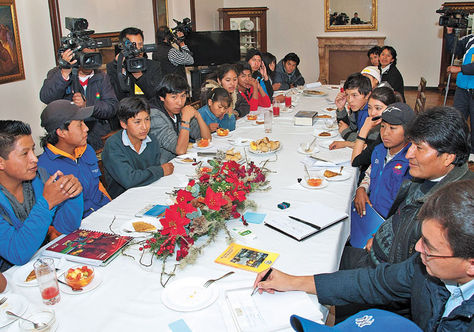The movements of working children in Bolivia have recently made international news for their productive meeting with President Evo Morales, after which he made an official statement that “child labor should not be banned.” Responding to a legislative proposal to ban all children under the age of fourteen from any kind of work, Morales drew on his own experience as a working child and on his conversation with representatives from the Bolivian working children’s movements to not only argue that banning child labor can make it more dangerous (as it goes underground) but also that working children are often working to support their families or to fund their own education, and thus demonstrate a “social conscience.” Echoing some of the language of the movement, Morales also clearly stated that child laborers should not be exploited, and that they deserve and need the protection of the state. Morales’ agreement with the NATs on the potential value and importance of their work is remarkable in the context of the hegemonic international narratives about the need to abolish all child labor and the ongoing pressure on developing nations to raise their minimum age laws. It is a statement that positions him in opposition to some powerful social and political forces and is being seen by working children’s movements around Latin America as a major success. Notes of congratulations and solidarity have been sent from the Latin American transnational movement and from several different national organizations of working kids. The meeting last week was the result of many years of organization, education, and advocacy, and came only after public indignation over violent police repression of a march of working children. It reminds us that children’s movements are not merely spaces of learning, but also can be highly effective at achieving their political goals. It also provides an opportunity to consider some of the tensions within public discourses on working children. The image of working children as pure victims — as tragic innocents exploited by unscrupulous adults — is hard to reconcile with the pictures of these same children sitting with the President, smiling, and telling him that they want to be able to keep their jobs. Working children’s voices and their stories about why they like their work and why they want to work substantially call into question the association of “child labor” only with its worst and most brutal forms. New calls for listening to children and for children’s “participation” in public life all suggest that children’s perspectives should be heard. But, the perspectives of working children challenge many of the common assumptions about child labor, making these voices hard to integrate into the hegemonic and “common-sense” public narratives. Thus, many of the news stories on this important meeting seem a bit confused, presenting a whole array of ILO statistics on child labor alongside the various statements of Morales and the NATs without attempting to figure out how these different elements actually relate to another.
Jessica K. Taft
Sociological fragments on kids, politics, and social change
© 2025 Jessica K. Taft
Theme by Anders Noren — Up ↑


Leave a Reply